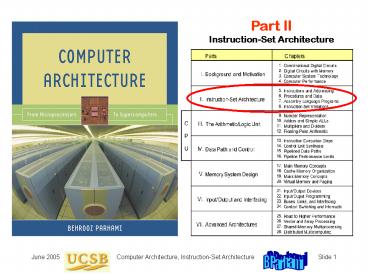Adventures on the Sea of Interconnection Networks - PowerPoint PPT Presentation
1 / 14
Title:
Adventures on the Sea of Interconnection Networks
Description:
Introduce machine 'words' and its 'vocabulary,' learning: A simple, yet realistic and useful ... Everything else needed to build and run assembly programs: ... – PowerPoint PPT presentation
Number of Views:40
Avg rating:3.0/5.0
Title: Adventures on the Sea of Interconnection Networks
1
Part IIInstruction-Set Architecture
2
II Instruction Set Architecture
- Introduce machine words and its vocabulary,
learning - A simple, yet realistic and useful instruction
set - Machine language programs how they are
executed - RISC vs CISC instruction-set design philosophy
3
7 Assembly Language Programs
- Everything else needed to build and run assembly
programs - Supply info to assembler about program and its
data - Non-hardware-supported instructions for
convenience
4
7.1 Machine and Assembly Languages
Figure 7.1 Steps in transforming an assembly
language program to an executable program
residing in memory.
5
Symbol Table
byte 0 byte 1 byte 2 byte 3
Figure 7.2 An assembly-language program, its
machine-language version, and the symbol table
created during the assembly process.
6
7.2 Assembler Directives
(See PH App. A, A.10, pp. A-47 to A-49 for more
details)
Assembler directives provide the assembler with
info on how to translate the program but do not
lead to the generation of machine instructions
.macro start macro (see Section 7.4)
.end_macro end macro (see Section 7.4)
.text start programs text segment
... program text goes here .data
start programs data segment tiny .byte
156,0x7a name initialize data byte(s) max
.word 35000 name initialize data
word(s) small .float 2E-3 name short float
(see Chapter 12) big .double 2E-3 name
long float (see Chapter 12) .align 2
align next item on word boundary array .space
600 reserve 600 bytes 150 words str1
.ascii ab name initialize ASCII string
str2 .asciiz xyz null-terminated ASCII
string .global main consider main a
global name
7
Composing Simple Assembler Directives
Example 7.1
Write assembler directive to achieve each of the
following objectives a. Put the error message
Warning The printer is out of paper! in
memory. b. Set up a constant called size with
the value 4. c. Set up an integer variable called
width and initialize it to 4. d. Set up a
constant called mill with the value 1,000,000
(one million). e. Reserve space for an integer
vector vect of length 250. Solution a.
noppr .asciiz Warning The printer is out of
paper! b. size .byte 4 small constant
fits in one byte c. width .word 4 byte
could be enough, but ... d. mill .word
1000000 constant too large for byte e. vect
.space 1000 250 words 1000 bytes
8
7.3 Pseudoinstructions
Example of one-to-one pseudoinstruction The
following not s0 complement
(s0) is converted to the real instruction
nor s0,s0,zero complement (s0)
Example of one-to-several pseudoinstruction The
following abs t0,s0 put (s0) into
t0 is converted to the sequence of real
instructions add t0,s0,zero copy x
into t0 slt at,t0,zero is x
negative? beq at,zero,4 if not, skip
next instr sub t0,zero,s0 the result is
0 x
9
MiniMIPS Pseudo-instructions
Copy
Arithmetic
Table 7.1
Shift
Logic
Memory access
Control transfer
10
7.4 Macroinstructions
A macro is a mechanism to give a name to an
oft-used sequence of instructions (shorthand
notation) .macro name(args) macro and
arguments named ... instrs defining the
macro .end_macro macro terminator How
is a macro different from a pseudoinstruction?
Pseudos are predefined, fixed, and look like
machine instructions Macros are user-defined
and resemble procedures (have arguments) How
is a macro different from a procedure?
Control is transferred to and returns from a
procedure After a macro has been replaced, no
trace of it remains
11
7.5 Linking and Loading
- The linker has the following responsibilities
- Ensuring correct interpretation (resolution)
of labels in all modules - Determining the placement of text and data
segments in memory - Evaluating all data addresses and instruction
labels - Forming an executable program with no
unresolved references - The loader is in charge of the following
- Determining the memory needs of the program
from its header - Copying text and data from the executable
program file into memory - Modifying (shifting) addresses, where needed,
during copying - Placing program parameters onto the stack (as
in a procedure call) - Initializing all machine registers, including
the stack pointer - Jumping to a start-up routine that calls the
programs main routine
12
7.6 Running Assembler Programs
Spim is a simulator that can run MiniMIPS
programs The name Spim comes from reversing
MIPS Three versions of Spim are available for
free downloading PCSpim for Windows
machines xspim for X-windows spim for Unix
systems You can download SPIM by visiting
http//www.cs.wisc.edu/larus/spim.html
13
Input/Output Conventions for MiniMIPS
Table 7.2 Input/output and control functions
of syscall in PCSpim.
Output
Input
Cntl
14
PCSpim User Interface
Figure 7.3































